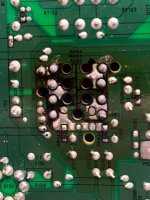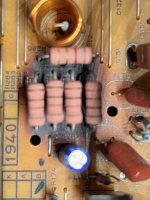I like to share some of my experiences with Yamaha budget Receivers R-S201, R-N303D, R-N402D and the more advanced R-N803D. This may help others to fix some problems I had with these devices.
For all these device detailed Yamaha service manuals can be found for free on the internet (e.g. on https://www.hifiengine.com/).
All these devices use the same NOBLE REB 161 PVB rotary encoder as input for a digital volume control circuit. The device is rated with a rotational life of 50000 to 100000 cycle. Sounds pretty much but on a R-S201 it failed, while using the volume knob the volume jumps unpredictable. Since a replacement part was hard to get I tried to fix it by carefully opening the rotary encoder and cleaning it by using contact spray and slightly bending the contacts. This worked well so far.
All recent Yamaha devices (Stereo, AV, amplifier, receiver) come with a build in protection function, which shutsdown or prevents the unit from starting in case a serious problem (like incorrect voltages in the power supply, high DC current on the output, high temperature, ...) is detected. The Yamaha service manual describes it in detail. In general, it is possible to enter a diagnostic mode or bypass the protection by pressing certain keys (e.g. "Bass+"+"Preset<"+"Power") while powering up the unit. The R-N303D occasionally reported a "PS1 PRT: 135L" error (actual value "135" may differ a little bit each time), which means the PS1 test voltage was too low (135 = 1.75V, expected range is 152-187 = 1,97V-2.42V). The PS1 test voltage is a combination of multiple power supply voltages via a resistor network, the resulting value is passed to an 8 Bit A/D converter (0-255 = 0-3.3V) on a microcontroller. If the value is out of range the unit shutsdown. Of course, there can be many reasons for an incorrect value. Amway in my case the solution was simple. I first verified the PS1 voltage is indeed too low. I verified that the main DC voltage after the main rectifier, which is part of the PS1 voltage, was correct, but then I noticed that all other voltages failed. All these other different voltages are generated from a pretty complex circuit; however this entire circuit gets its input voltage from a resistor series R281-R285 (8,2 Ohm, 2 Watt each). According to the Service manual there seemed to be a modification in the past here ("New Parts" footnote). On my device it looks like if these resistors had already been repaired in the past (perhaps with the modified new parts?) but one of the solder points of one resistor was bad causing temporary failure. After fixing the solder point the device started up reliable. I also noticed that these 5 resistors can get pretty warm (~80C), so these resistors are loaded quite heavily and perhaps may fail.
The R-N303D, R-N402D are budget devices. You get a lot of features for the price, but you cannot expect the same build and sometimes sound quality as from a more expensive device like the R-N803D. I like to mention one important but not so obvious difference. The residual noise floor of the R-N303D and R-N402D is a lot higher compared to the R-N803D. This can become a serious issue in combination with high sensitivity loudspeaker and/or nearfield listening. E.g. in combination with my Lowther Fidelio (~96db 1w/1m) the R-N303D and R-N402D generate an almost unacceptable clearly audible hiss, while the R-N803D is absolutely quiet. The root cause is probably how the volume control is implemented. The R-N303D, R-N402D use a Rohm BD3491FS for digital volume control while the R-N802D uses a Rohm BD34703KS2, which has a 5 times lower residual noise rating (1uV vs. 5 uV). Since that gets directly amplified by the power amplifier section it can make a big difference. So I definitely cannot recommend the R-N303D, R-N402D for listening at lower volume using high sensitive loudspeakers. However, in combination with average sensitive loudspeakers this is no issue at all.
For all these device detailed Yamaha service manuals can be found for free on the internet (e.g. on https://www.hifiengine.com/).
All these devices use the same NOBLE REB 161 PVB rotary encoder as input for a digital volume control circuit. The device is rated with a rotational life of 50000 to 100000 cycle. Sounds pretty much but on a R-S201 it failed, while using the volume knob the volume jumps unpredictable. Since a replacement part was hard to get I tried to fix it by carefully opening the rotary encoder and cleaning it by using contact spray and slightly bending the contacts. This worked well so far.
All recent Yamaha devices (Stereo, AV, amplifier, receiver) come with a build in protection function, which shutsdown or prevents the unit from starting in case a serious problem (like incorrect voltages in the power supply, high DC current on the output, high temperature, ...) is detected. The Yamaha service manual describes it in detail. In general, it is possible to enter a diagnostic mode or bypass the protection by pressing certain keys (e.g. "Bass+"+"Preset<"+"Power") while powering up the unit. The R-N303D occasionally reported a "PS1 PRT: 135L" error (actual value "135" may differ a little bit each time), which means the PS1 test voltage was too low (135 = 1.75V, expected range is 152-187 = 1,97V-2.42V). The PS1 test voltage is a combination of multiple power supply voltages via a resistor network, the resulting value is passed to an 8 Bit A/D converter (0-255 = 0-3.3V) on a microcontroller. If the value is out of range the unit shutsdown. Of course, there can be many reasons for an incorrect value. Amway in my case the solution was simple. I first verified the PS1 voltage is indeed too low. I verified that the main DC voltage after the main rectifier, which is part of the PS1 voltage, was correct, but then I noticed that all other voltages failed. All these other different voltages are generated from a pretty complex circuit; however this entire circuit gets its input voltage from a resistor series R281-R285 (8,2 Ohm, 2 Watt each). According to the Service manual there seemed to be a modification in the past here ("New Parts" footnote). On my device it looks like if these resistors had already been repaired in the past (perhaps with the modified new parts?) but one of the solder points of one resistor was bad causing temporary failure. After fixing the solder point the device started up reliable. I also noticed that these 5 resistors can get pretty warm (~80C), so these resistors are loaded quite heavily and perhaps may fail.
The R-N303D, R-N402D are budget devices. You get a lot of features for the price, but you cannot expect the same build and sometimes sound quality as from a more expensive device like the R-N803D. I like to mention one important but not so obvious difference. The residual noise floor of the R-N303D and R-N402D is a lot higher compared to the R-N803D. This can become a serious issue in combination with high sensitivity loudspeaker and/or nearfield listening. E.g. in combination with my Lowther Fidelio (~96db 1w/1m) the R-N303D and R-N402D generate an almost unacceptable clearly audible hiss, while the R-N803D is absolutely quiet. The root cause is probably how the volume control is implemented. The R-N303D, R-N402D use a Rohm BD3491FS for digital volume control while the R-N802D uses a Rohm BD34703KS2, which has a 5 times lower residual noise rating (1uV vs. 5 uV). Since that gets directly amplified by the power amplifier section it can make a big difference. So I definitely cannot recommend the R-N303D, R-N402D for listening at lower volume using high sensitive loudspeakers. However, in combination with average sensitive loudspeakers this is no issue at all.
Attachments
Hi Randolf,
I came across your feedback while searching a solution to that annoying hiss from the 402d. I recently bought one, plugged it to my Cantons and immediately heard it. So I was curious if it was technically possible to get rid of the problem replacing the noisy Rohm BD3491FS with the Rohm BD34703KS2 on RN402d instead of upgrading the whole reciever. Are these chips compatible?
I came across your feedback while searching a solution to that annoying hiss from the 402d. I recently bought one, plugged it to my Cantons and immediately heard it. So I was curious if it was technically possible to get rid of the problem replacing the noisy Rohm BD3491FS with the Rohm BD34703KS2 on RN402d instead of upgrading the whole reciever. Are these chips compatible?
Hi,
the 2 chips are not compatible in any way and do not have the same feature set:
https://fscdn.rohm.com/en/products/databook/datasheet/ic/audio_video/audio_processor/bd3491fs-e.pdf
https://fscdn.rohm.com/en/products/.../audio_video/audio_processor/bd34701ks2-e.pdf
The BD3491FS is an input selector, volume control and tone control device. BD34703KS2 is an input selector and volume control too but lacks tone control.
In case you don't need the full power you might try to add an attenuation (~ -6....-12db) between BD3491FS outputs (PIN 21 and 25) and power amplifier inputs section, eventually with a switch to bypass the attenuation if you need the full power. But be aware that this requires some knowledge and you may break the device if you do it wrong. Also, Yamaha amplifiers and receivers do quite some power up checks, e.g. I tried to disconnect the pre amplifier and power amplifier of the R-N802 once (to loop in a DSP later), this immediately causes the device to not startup anymore (looks like they send some test tones through the entire device and check the output during startup). Furthermore many parts are SMDs, which makes it even harder to do any modifications
Best regards
Randolf
the 2 chips are not compatible in any way and do not have the same feature set:
https://fscdn.rohm.com/en/products/databook/datasheet/ic/audio_video/audio_processor/bd3491fs-e.pdf
https://fscdn.rohm.com/en/products/.../audio_video/audio_processor/bd34701ks2-e.pdf
The BD3491FS is an input selector, volume control and tone control device. BD34703KS2 is an input selector and volume control too but lacks tone control.
In case you don't need the full power you might try to add an attenuation (~ -6....-12db) between BD3491FS outputs (PIN 21 and 25) and power amplifier inputs section, eventually with a switch to bypass the attenuation if you need the full power. But be aware that this requires some knowledge and you may break the device if you do it wrong. Also, Yamaha amplifiers and receivers do quite some power up checks, e.g. I tried to disconnect the pre amplifier and power amplifier of the R-N802 once (to loop in a DSP later), this immediately causes the device to not startup anymore (looks like they send some test tones through the entire device and check the output during startup). Furthermore many parts are SMDs, which makes it even harder to do any modifications
Best regards
Randolf

